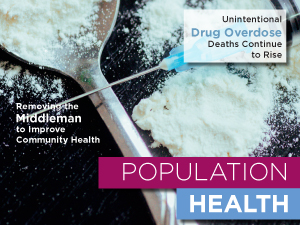
Source: Spring 2018 Editor’s Message by Ed Bope, MD
With the spring issue of The Ohio Family Physician (TOFP), we welcome Morgan Pelt, our new communications manager and managing editor. You will immediately see her mark on our magazine, with more color and imagery, coinciding with articles and research studies. Morgan and I will work closely to bring you a fresh, important issue each quarter, and welcome your ideas and contributions. As she joins the Ohio Academy of Family Physicians family, Wilburn H. Weddington, MD, leaves us. With a heartfelt tribute provided by Gary L. LeRoy, MD, it demonstrates the affect one person can have not only on the individual, but the entire community.
This issue is about population health and how we, as family physicians, are in a unique position to improve the health of our patients and our communities. Through daily interactions with patients, the article Removing the Middleman to Improve Community Health by Ryan Kauffman, MD, explains how family physicians can implement direct primary care into their practices, allowing more time to explore the social determinants of health that affect one’s patients. We also address population health in the article, Providing Culturally Competent Care to Ohio’s Growing LGBTQ Community, when it comes to providing care to individuals who identify as lesbian, bisexual, gay, transgender, or queer or questioning. Ramona Peel, lead trainer of Equitas Health, provides her insight and how family physicians can do more for this growing community.
Think of the physician that led an effort to expose and correct lead contaminated water found in the public water supply system in Flint, MI. Consider our role in vaccinating the nation to prevent harsh flu seasons. You are involved in population health, whether you see it or not. The OAFP president presents a thought-provoking article about single-payer healthcare and how the U.S. medical system compares to other countries across the world. Can anyone look at the data and deny that the low ratio of family physicians to population in the United States is a key factor in managing our population and their health?
A first for this issue, a well-written article by a high school student explores the impact that communities and families across the nation, more specifically Ohio, are encountering with narcotics. This student already understands that population health needs to be addressed when providing a solution to the opioid epidemic. Finally, an article Reducing Infant Mortality through Postpartum Depression Screenings by family physicians at the Riverside Methodist Hospital Family Medicine Residency Program, reminds us that while the birth of a child is a joyful time for most, it can be surrounded by anxiety and depression for others. Indeed, we have one of the best jobs in the world, but more importantly, we must be involved in all aspects of our community when it comes to keeping Ohio families healthy, and advancing family medicine.
Each TOFP issue is available in print and digital formats. If you would like to change how you receive TOFP, please contact Membership Services Manager Emily Pavoni or call 800.742.7327.




